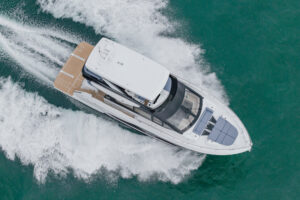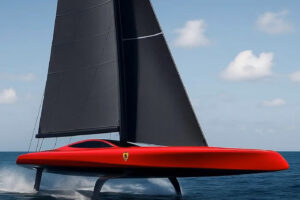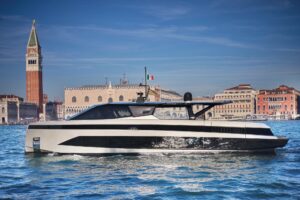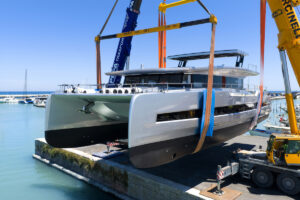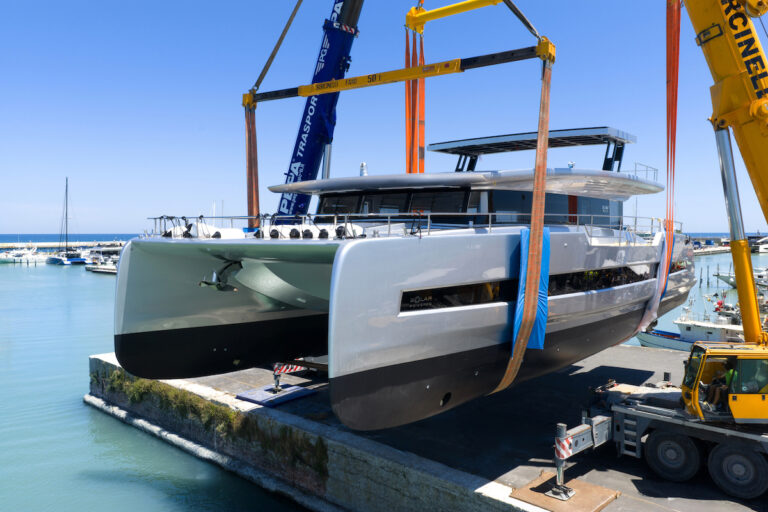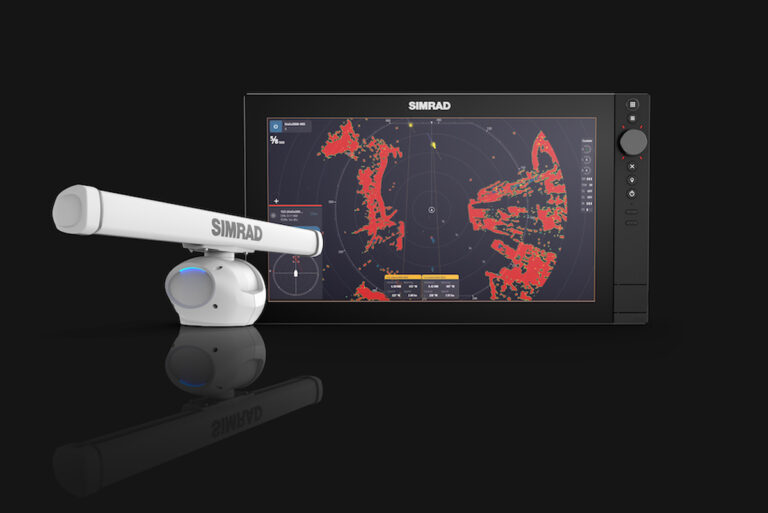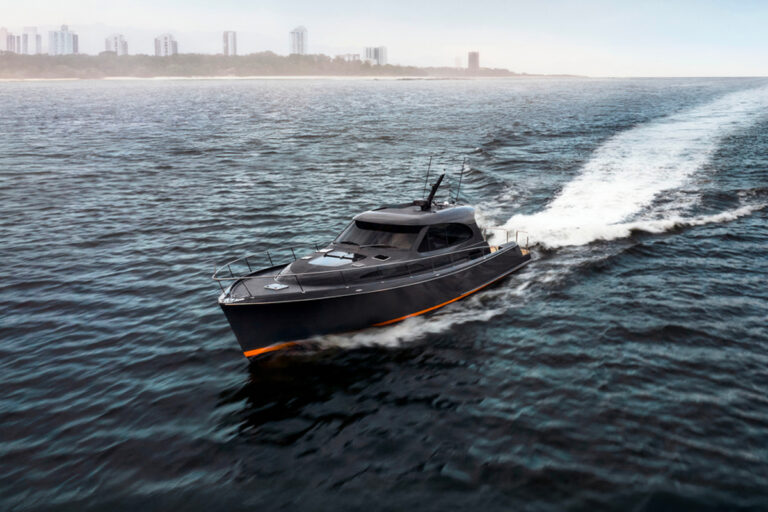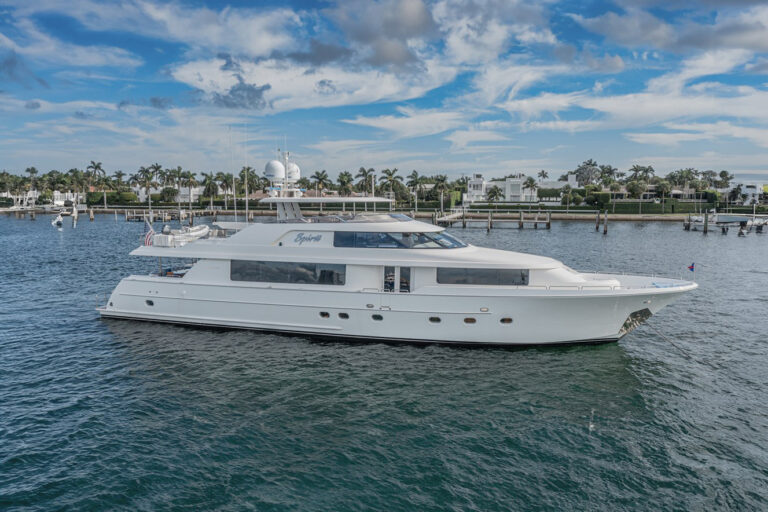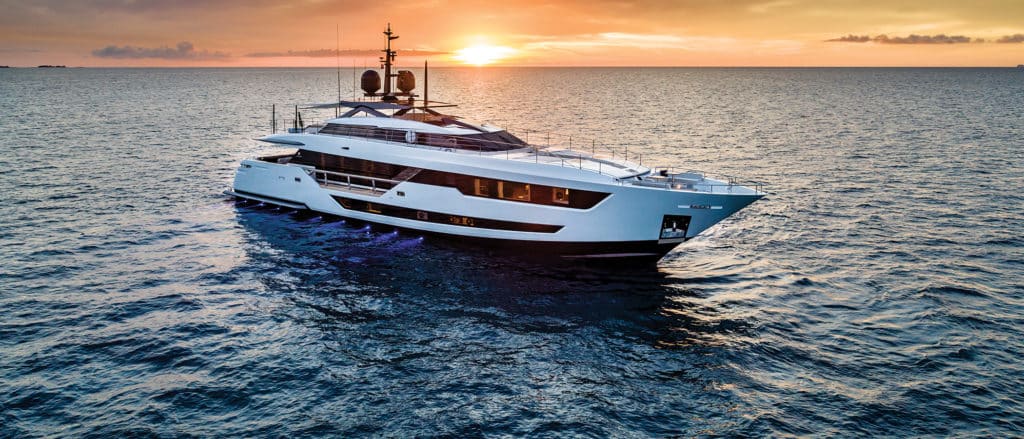
The first Custom Line 120, Vista Blue, is a water toy on steroids. Milan-based yacht designer Francesco Paszkowski’s first effort with the Ferretti Group brings the outside inside. Sole-to-overhead windows surround the salon for sweeping ocean views, although the scene stealers are the sliding doors leading to the cockpit. Closed, the two-piece, electrically operated doors have an airy appeal, but the entire bulkhead (including the door frame) hinges up into a recess in the cockpit overhang. The system was developed with an aerospace company, and it results in a seamless transition from the transom all the way to the 10-seat formal dining area forward of the salon. Adding to the alfresco feel is the cockpit’s teak planking, which continues forward beyond the wet bar and into the salon. Vista Blue’s exterior is also dramatic, with a leaning-into-the-sea profile and bold, black stripes that conceal the hull and deckhouse windows. The Custom Line 120 has a fast-cruise, semidisplacement hull, and the owners of Vista Blue base in the Bahamas. With her 26-knot top speed and 7-foot draft with prop tunnels, they have rapid access to hundreds of watery delights, from Harbour Island to the Exumas and beyond. Power for the Custom Line 120 is a pair of 2,638 hp MTU 16V 2000 M94 diesels, providing a 1,050-nautical-mile range at a cruise speed of 11 knots. ABT-TracStar at-rest stabilizers should keep the yacht steady at anchor. Accommodations for 10 guests start with a 375-square-foot main-deck master stateroom that spans the 25-foot-1-inch beam. The his-and-hers head is finished in travertino bronze and is also full-beam. The stateroom has a desk under a window, a seating area with a Saarinen cocktail table, and walk-in closets. Stitched Italian leather covers the wardrobe bulkheads.

Two mirrored VIP staterooms are aft on the lower deck, with island berths athwartships to maximize the view through the hullside windows. Amidships, off the companionway, are two more guest staterooms with twin berths and fold-down Pullmans. Four cabins are forward to sleep seven crew, with entry to the guest level for housekeeping.
The galley is European-style and separated from the guest areas, with a pantry and prep area opening to the salon. There’s a door to the side deck, and stairs down to the crew quarters. Miele cooktops and an oven, plus a full-size fridge backed by undercounter drawers, should stow enough provisions for a week or more of cruising.
The pilothouse has a centerline helm seat, a chart table to port, and an L-shaped settee with a table aft and to starboard. Steps here lead up to the flybridge as well as down to the galley.
Outdoor enjoyment dominates on the flybridge. A batwing hardtop with a sunroof covers the forward half, and high bulwarks with panoramic-size windows surround the space, allowing views from the protected Minotti chaise longues and settees. Aft, sun pads border a Teuco spa, and misters are fitted for hot Bahamas days.

Teak-planked side decks lead from the bridge forward to another getaway space: the raised foredeck with sun pads, tables, settees and, at anchor, umbrellas for shade. Under the foredeck, and out of sight to all but the crew, is another tender garage with its own crane. Counting the transom garage, this yacht has spaces to stow three tenders out of sight.
The afterdeck has more Minotti loose furniture in a cocktail arrangement, and here, Custom Line and Paszkowski incorporated the builder’s Dual Mode Transom. The door to the transom garage hinges two ways: Swinging up, it provides launching and retrieval of the Williams tender, while hinged down, it reveals a teak beach club that extends into the hull, creating an oversize swim platform.

The owner’s representative and yacht broker, Jason Wood, attests to the high quality of the construction, having stayed at the Ferretti Group yard in La Spezia, Italy, during the build. “To keep Vista Blue — and other Custom Line 120s — light but very strong, the yard uses resin infusion and carbon fiber for a perfect blend,” he says.
Built to RINA and MCA standards, the 120 has floating soles and supplementary thermal insulation in bulkheads and overheads to ensure a quiet and vibration-free ride.
The Custom Line 120 is a clever amalgam of space, style, luxury and performance that should appeal to owners looking to make the mega-yacht move.
Water Toys Galore
Vista Blue has fun to spare. Start with the Nor-Tech 390 Sport that pushes past the 80 mph mark. Then there’s the 16-foot-5-inch Williams Dieseljet 505 that goes up to 40 mph. Stir in a pair of Yamaha HO WaveRunners and a couple of Seabobs with fore-and-aft cameras. Season with paddleboards, scuba gear, fishing equipment, and inflatables like bananas and trampolines, and you have a sure recipe for fun on the water.
Lots of Class
The Custom Line 120 is built to class, meaning it follows the construction and safety regulations from classification societies, which set technical standards to assess and maintain yachts. The 120 is built to RINA (Registro Italiano Navale), which was founded in 1857 in Genoa, Italy, and to MCA (Maritime and Coastguard Agency), the British group whose codes govern commercial and charter yachts carrying up to 36 passengers.
A Word with Designer Francesco Paszkowski
Yachting: The 120 takes a different approach than many other Ferretti Group projects. Why? FP: The design for the new Custom Line 120 introduces new stylistic elements focused on breaking down barriers between the exterior and the interior. Yachting: In particular?
FP: The unusual ceiling opening system for the aft windows further emphasizes the desire to bring the exterior and interior together. It also transforms the aft section of the living area, which is usually not heavily used, into a space that can be enjoyed whether the doors are closed or open.

